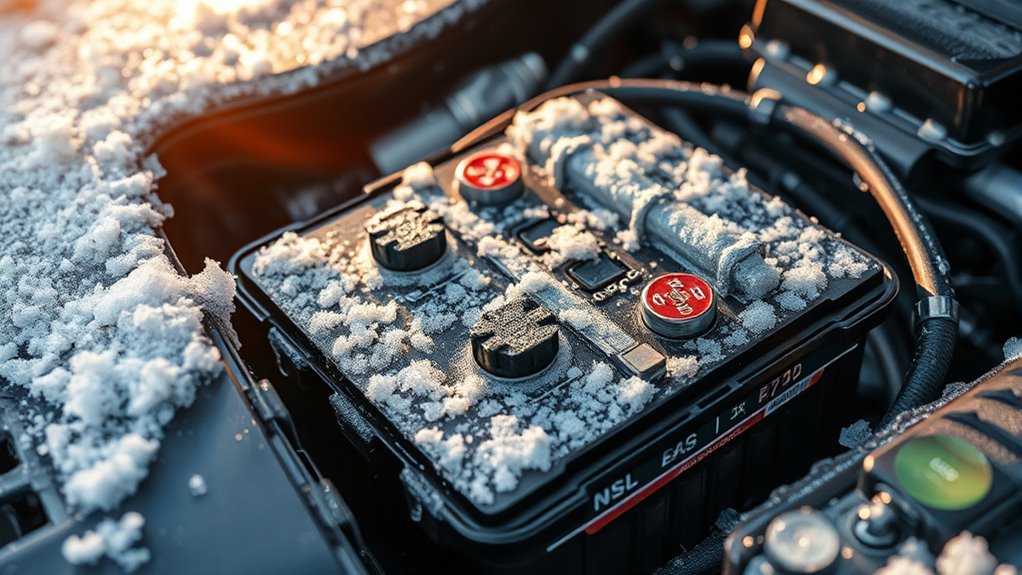In extreme hot and cold weather, you need to adjust your car battery care. Hot temperatures speed up chemical reactions and electrolyte evaporation, so inspect terminals regularly, keep connections clean, and replace batteries over 3-5 years. Cold reduces power output, so keep your battery charged, test it beforehand, and use warmers if needed. Proper maintenance and charging techniques help your battery last longer and keep your vehicle reliable in all weather. Learn more to fully protect your battery year-round.
Key Takeaways
- Regularly inspect and clean battery terminals to prevent corrosion and ensure good connections in all weather conditions.
- Keep the battery fully charged, especially in cold weather, using trickle chargers or warmers to prevent freezing and loss of power.
- In hot weather, replace batteries older than 3-5 years and monitor electrolyte levels to avoid capacity loss and electrolyte evaporation.
- Follow proper jump-start procedures and avoid electrical accessories running when the engine is off to prevent drain.
- Use seasonal maintenance strategies like battery testing before winter and avoiding excessive electrical load during hot weather for longevity.

Your car battery is essential for starting your vehicle and powering its electrical systems, so taking proper care of it can save you time and money. Extreme weather conditions, whether scorching heat or freezing cold, can really put your battery’s health to the test. In hot weather, the intense heat accelerates the chemical reactions inside your battery, which can lead to quicker deterioration. Conversely, cold temperatures slow down the chemical processes, making it harder for your battery to generate the power needed to start your engine. That’s why proper battery maintenance and understanding the right charging procedures become even more critical during these extremes.
In hot weather, you should regularly check your battery’s condition, paying close attention to corrosion on the terminals and ensuring they’re clean and tightly connected. The heat can cause the electrolyte inside the battery to evaporate, reducing its overall capacity. To counteract this, you might need to top off the electrolyte levels if your battery is not sealed, or consider replacing it if it’s older than three to five years. During high temperatures, it’s also wise to avoid leaving electrical accessories like the air conditioner or radio running when the engine isn’t on, as these can drain your battery faster. Proper battery maintenance involves not only inspecting the terminals but also ensuring that your charging procedures are correct. If your battery shows signs of weakness, a professional can perform a load test or check the voltage to determine if it needs recharging or replacing. Additionally, understanding how security systems can influence your vehicle’s electrical load helps prevent unexpected battery drain.
When cold weather hits, your focus shifts to ensuring your battery retains enough charge to start the engine. Cold temperatures reduce the battery’s ability to produce current, so it’s essential to keep it fully charged. Before winter, consider having your battery tested to confirm it’s in good shape. If your vehicle struggles to start on cold mornings, a trickle charger or a battery warmer can help maintain suitable charge levels and prevent freezing. When jump-starting in winter, always follow proper charging procedures: connect the cables correctly, start the booster vehicle first, and give your battery a few moments to build up strength before attempting to start your car. After starting, let your engine run for a few minutes to allow the alternator to recharge the battery. Regularly inspecting your battery’s condition and ensuring it’s properly charged during extreme weather can prevent inconvenient breakdowns and extend its lifespan.
Ultimately, understanding how extreme temperatures affect your battery and adapting your maintenance and charging procedures accordingly can save you from unexpected failures. Whether it’s keeping terminals clean in the heat or ensuring a full charge in the cold, proactive care is your best defense. Proper battery maintenance isn’t just about avoiding breakdowns; it’s about making sure your vehicle runs smoothly no matter the weather.
Frequently Asked Questions
How Does Altitude Affect Car Battery Performance in Extreme Weather?
Altitude challenges can markedly impact your car battery performance, especially in extreme weather. As you drive at higher altitudes, the thinner air may cause your battery to work harder, reducing its efficiency and lifespan. Cold temperatures at higher elevations further strain your battery, making starting your car tougher. To keep your battery in top shape, check it regularly, and consider a professional inspection to address altitude challenges effectively.
Can Using Premium Fuel Improve Battery Life During Hot or Cold Conditions?
Using premium fuel can slightly improve your battery’s performance during hot or cold weather. Higher fuel quality often contains better additives, which help keep your engine running smoothly and reduce strain on your battery. While it doesn’t directly extend battery life, using premium fuel with proper battery additives can prevent corrosion and buildup, ultimately supporting your battery’s health in extreme temperatures. Remember, regular maintenance is still essential for superior performance.
Are There Specific Battery Types Better Suited for Extreme Climates?
When choosing a battery, you should consider climate-specific batteries tailored for extreme conditions. Some battery types, like AGM or enhanced flooded batteries, perform better in hot or cold weather because they’re designed to handle temperature fluctuations. Your best bet is to select a battery type suited for your climate, ensuring reliable starts and longer lifespan. Proper battery type selection helps prevent unexpected failures in harsh weather conditions.
How Often Should I Replace My Battery in Extreme Weather?
You should replace your battery when its lifespan approaches or if it shows signs of failing, especially in extreme weather. Regularly check your battery’s condition and follow a maintenance schedule to catch issues early. In harsh conditions, batteries tend to wear out faster, so consider replacing them every 3-5 years or sooner if you notice slow starts or dim lights. Staying proactive ensures reliable performance regardless of weather extremes.
What Are Signs My Battery Is Failing Due to Weather Conditions?
Thinking your battery’s plotting a rebellion? Watch for signs like corrosion around terminals, which screams neglect, or voltage fluctuations that make your car act like it’s had too much coffee. Cold weather can freeze your battery’s spirit, while heat cooks its life away. If your engine struggles to start or dims unexpectedly, don’t ignore it. These clues mean your battery’s weather-fighting days are numbered—time for a check-up!
Conclusion
Think of your car battery as the heart of your vehicle—its health reflects your care. In extreme weather, giving it proper attention is like tending to a delicate garden, ensuring it blossoms even in harsh conditions. When you shield your battery from the heat or cold, you’re not just protecting a machine, but nurturing the very pulse that keeps your journey alive. Show it love, and it’ll keep your adventures thriving, no matter the season.









